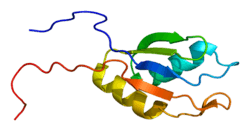RBM14
RNA-binding protein 14 is a protein that in humans is encoded by the RBM14 gene.[1][2]
Interactions
RBM14 has been shown to interact with TARBP2.[3]
References
- ↑ Brett D, Whitehouse S, Antonson P, Shipley J, Cooper C, Goodwin G (February 1998). "The SYT protein involved in the t(X;18) synovial sarcoma translocation is a transcriptional activator localised in nuclear bodies". Hum Mol Genet 6 (9): 1559–64. doi:10.1093/hmg/6.9.1559. PMID 9285794.
- ↑ "Entrez Gene: RBM14 RNA binding motif protein 14".
- ↑ Iwasaki T, Chin WW, Ko L (September 2001). "Identification and characterization of RRM-containing coactivator activator (CoAA) as TRBP-interacting protein, and its splice variant as a coactivator modulator (CoAM)". J. Biol. Chem. 276 (36): 33375–83. doi:10.1074/jbc.M101517200. PMID 11443112.
Further reading
- Maruyama K, Sugano S (1994). "Oligo-capping: a simple method to replace the cap structure of eukaryotic mRNAs with oligoribonucleotides.". Gene 138 (1-2): 171–4. doi:10.1016/0378-1119(94)90802-8. PMID 8125298.
- Suzuki Y, Yoshitomo-Nakagawa K, Maruyama K, Suyama A, Sugano S (1997). "Construction and characterization of a full length-enriched and a 5'-end-enriched cDNA library.". Gene 200 (1-2): 149–56. doi:10.1016/S0378-1119(97)00411-3. PMID 9373149.
- Iwasaki T, Chin WW, Ko L (2001). "Identification and characterization of RRM-containing coactivator activator (CoAA) as TRBP-interacting protein, and its splice variant as a coactivator modulator (CoAM).". J. Biol. Chem. 276 (36): 33375–83. doi:10.1074/jbc.M101517200. PMID 11443112.
- Andersen JS, Lyon CE, Fox AH, Leung AK, Lam YW, Steen H et al. (2002). "Directed proteomic analysis of the human nucleolus.". Curr. Biol. 12 (1): 1–11. doi:10.1016/S0960-9822(01)00650-9. PMID 11790298.
- Brill LM, Salomon AR, Ficarro SB, Mukherji M, Stettler-Gill M, Peters EC (2004). "Robust phosphoproteomic profiling of tyrosine phosphorylation sites from human T cells using immobilized metal affinity chromatography and tandem mass spectrometry.". Anal. Chem. 76 (10): 2763–72. doi:10.1021/ac035352d. PMID 15144186.
- Beausoleil SA, Jedrychowski M, Schwartz D, Elias JE, Villén J, Li J et al. (2004). "Large-scale characterization of HeLa cell nuclear phosphoproteins.". Proc. Natl. Acad. Sci. U.S.A. 101 (33): 12130–5. doi:10.1073/pnas.0404720101. PMC 514446. PMID 15302935. Vancouver style error (help)
- Perani M, Antonson P, Hamoudi R, Ingram CJ, Cooper CS, Garrett MD et al. (2006). "The proto-oncoprotein SYT interacts with SYT-interacting protein/co-activator activator (SIP/CoAA), a human nuclear receptor co-activator with similarity to EWS and TLS/FUS family of proteins.". J. Biol. Chem. 280 (52): 42863–76. doi:10.1074/jbc.M502963200. PMID 16227627.
- Nousiainen M, Silljé HH, Sauer G, Nigg EA, Körner R (2006). "Phosphoproteome analysis of the human mitotic spindle.". Proc. Natl. Acad. Sci. U.S.A. 103 (14): 5391–6. doi:10.1073/pnas.0507066103. PMC 1459365. PMID 16565220. Vancouver style error (help)
- Lim J, Hao T, Shaw C, Patel AJ, Szabó G, Rual JF et al. (2006). "A protein-protein interaction network for human inherited ataxias and disorders of Purkinje cell degeneration.". Cell 125 (4): 801–14. doi:10.1016/j.cell.2006.03.032. PMID 16713569. Vancouver style error (help)
- Sui Y, Yang Z, Xiong S, Zhang L, Blanchard KL, Peiper SC et al. (2007). "Gene amplification and associated loss of 5' regulatory sequences of CoAA in human cancers.". Oncogene 26 (6): 822–35. doi:10.1038/sj.onc.1209847. PMID 16878147.
- Beausoleil SA, Villén J, Gerber SA, Rush J, Gygi SP (2006). "A probability-based approach for high-throughput protein phosphorylation analysis and site localization.". Nat. Biotechnol. 24 (10): 1285–92. doi:10.1038/nbt1240. PMID 16964243. Vancouver style error (help)
- Olsen JV, Blagoev B, Gnad F, Macek B, Kumar C, Mortensen P et al. (2006). "Global, in vivo, and site-specific phosphorylation dynamics in signaling networks.". Cell 127 (3): 635–48. doi:10.1016/j.cell.2006.09.026. PMID 17081983.
- Yang Z, Sui Y, Xiong S, Liour SS, Phillips AC, Ko L (2007). "Switched alternative splicing of oncogene CoAA during embryonal carcinoma stem cell differentiation.". Nucleic Acids Res. 35 (6): 1919–32. doi:10.1093/nar/gkl1092. PMC 1874587. PMID 17337438.
| |||||||||


